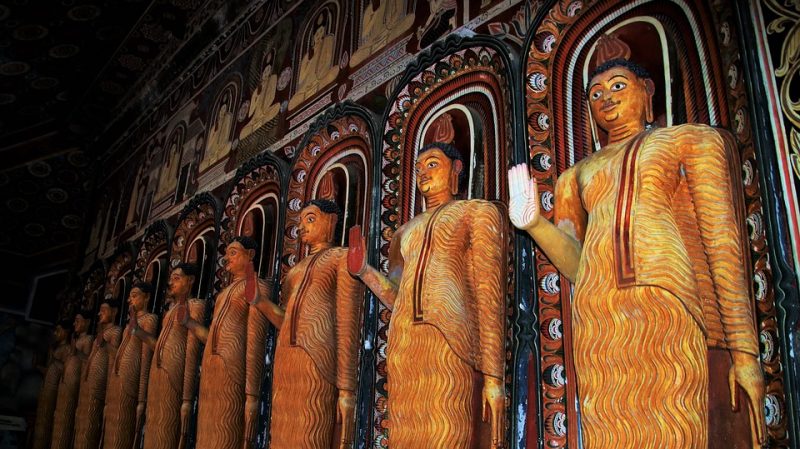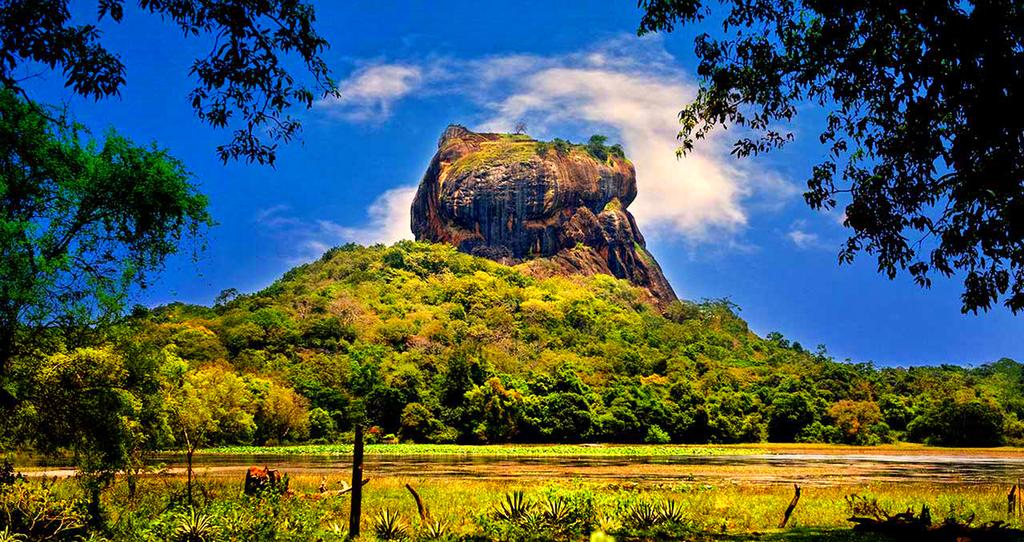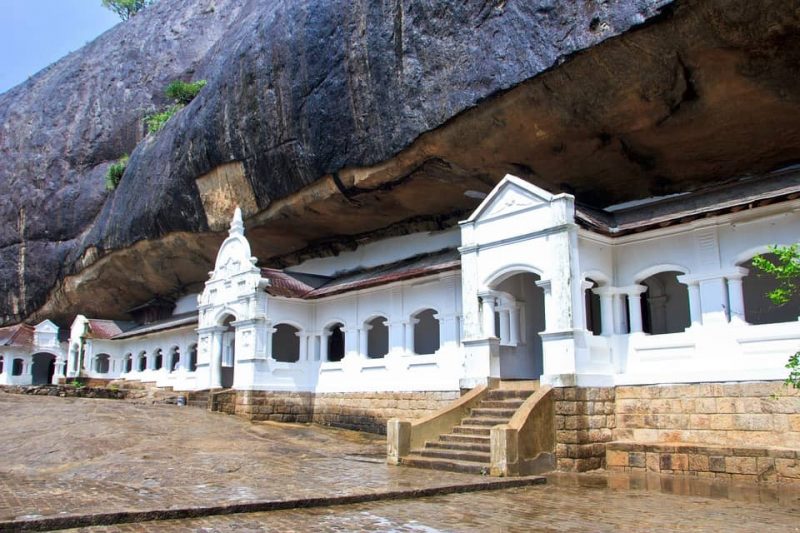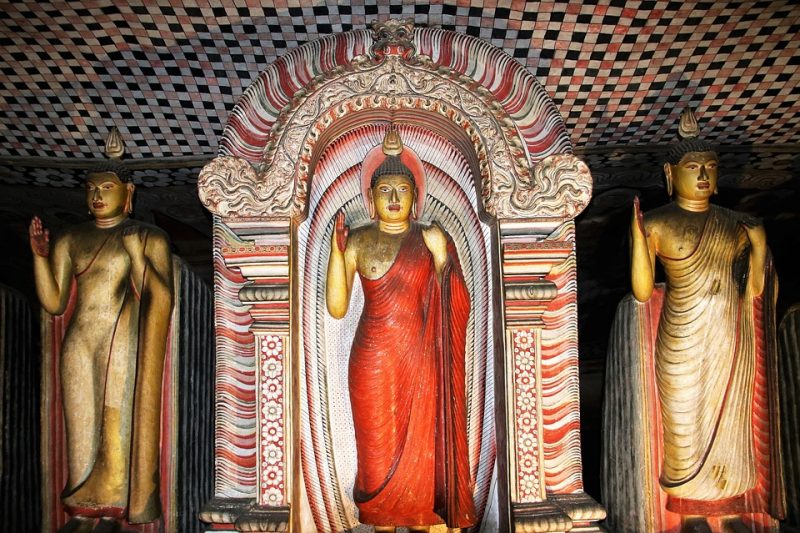
Sigiriya and Dambulla in one day with Pidurangala
Sigiriya, Dambulla and Pidurangala cave temple, all 3 places are important tourist attractions located in the cultural triangle of Sri Lanka, which is also a part of the most cultural triangle tours. Sigiriya and Dambulla caves are 2 of the most visited spots in the cultural triangle of Sri Lanka and Pidurangala cave temple is also visited by travellers, who visit Sigiriya rock because the temple is conveniently located within easy reach of Sigiriya rock.
Table of Contents
- Sigiriya, Dambulla and Pidurangala cave temple
- Can we visit Sigiriya and Dambulla in one day?
- Sigiriya and Dambulla one-day trip
- Sigiriya and Dambulla trip from west coast hotels in a nutshell
- Sigiriya and Dambulla Caves, Pidurangala rock
- Sigiriya tour
- Sigiriya fresco paintings
- International accolades for Sigiriya
- Sigiriya in the eyes of the historians
- Kandy to Sigiriya
- Kandy to Sigiriya day trip
- Places to visit on a day trip from Kandy to Sigiriya and Dambulla?
- Kandy to Sigiriya day trip in a nutshell
- Dambulla Tour
- Visiting Dambulla cave temple: what you need to know
- Sigiriya to Dambulla
- Visiting Dambulla golden cave temple
- How to go from Dambulla to Sigiriya?
- Visiting the Pidurangala cave temple
- For spiritual charm: Pidurangala
- History of Pidurangala cave temple
- History of Pidurangala cave temple
- How do I go to the Pidurangala rock cave temple?
- What do I see in the Pidurangala cave temple?
- What do I see in the Pidurangal rock cave temple?
Visiting the iconic tourist attraction of Sigiriya is on the bucket list of most foreign travellers in Sri Lanka. Sigiriya is a UNESCO world heritage site and an important monument in the cultural triangle. Usually, the Sigiriya one-day tour from Colombo also includes Dambulla golden temple as well as Pidurangala ancient temple, which are located only a few kilometres from the Sigiriya rock fortress. The day tour from Colombo to Sigiriya and Dambulla is one of the very popular day tours, which is a very popular days tour. This one-day trip allows the tourist to explore Sigiriya and Dambulla in one day with the Pidurangala cave temple.
Sigiriya, Dambulla and Pidurangala cave temple
All 3 places have very important historical and cultural importance, while the Pidurangala rock cave temple and Dambulla caves are popular Buddhist temples in the country. All 3 places are located very close to each other, hence the travellers can visit all these places in a single trip. These 3 tourist attractions are included in our 2 weeks Sri Lanka itinerary. However, these 3 places are included in most other trips such as 5 day Sri Lanka tour to the cultural triangle and 7 days classical tour.
Can we visit Sigiriya and Dambulla in one day?
Yes! Sigiriya and Dambulla one-day trip places in Sri Lanka from Colombo. in fact, Visiting Sigiriya and Dambulla is a very popular activity among travellers in Sri Lanka because both places are important historical places. The tourists can cover both places on a day trip from most beach resorts on the west and coast and Colombo, because it is only 30 minutes drive from Dambulla to Sigiriya and vice-versa.
Sigiriya and Dambulla’s one-day trip can be booked from most west coast beach resorts such as Bentota and Colombo. Seerendipity tours is a pioneer travel company that organizes Sigiriya and Dambulla one-day tours and many other day trips to all important tourist places in Sri Lanka. They also provide Sigiriya and Dambulla one day trip through GetYourGuide.
This Sigiriya and Dambulla one-day trip start early morning (Colombo and west coast) due to the time to be spent on travelling. If it is west coast hotel or in Colombo, the starting time is 04.00 am and if you stay in a south coast beach hotel you need to start the trip at around 03.30 am.
The transfer from west coast Beach resort to Sigiriya takes around 4 hours and you will be spending around 3 hours in both places. The return journey will also take a little more than 4 hours, which means you will be returning to the hotel at around 06.00 pm.
Sigiriya and Dambulla one-day trip
Sigiriya and Dambulla trip from west coast hotels in a nutshell
- 04.00 am start the trip from the hotel
- 08.00 am reach Sigiriya rock fortress
- 10.00 am finish the climb at Sigiriya
- 11.00 am reach Dambulla cave and visit the temple
- 12.30 pm lunch break
- 01.30 pm start return transfer
- 06.00 pm reach the hotel in Bentota
Sigiriya and Dambulla Caves, Pidurangala rock
Dambulla cave temple and Sigiriya rock fortress are places declared as UNESCO world heritage sites due to their cultural and historical importance. Most visitors to Sri Lanka never fail to include Sigiriya and Dambulla caves in their Sri Lanka trips. Same time many tourists do not fail to make a visit to the Piduranagla rock temple due to its religious and historical importance. Especially the visitors to Sigiriya rock fortress can visit Pidurangala rock after a 10-minute walk from Sigiriya rock.
Sigiriya tour
Sigiriya is a monolith and this natural attraction to human touch originated in the 5th century AD. It functioned as a fortress more than 1500 years ago, even today a large number of holidaymakers gather here to witness the gardens, reservoirs, swimming pools, ruins of places and audience halls that existed in the early days of the fortress.
Perhaps Sigiriya is the most iconic natural rock, which rises up to 300 meters from sea level, in the northern plains of Sri Lanka. It is truly a symbol of advanced knowledge of water management, urban planning and defence. There may be a large number of similar rocks in the region that surpass the magnitude size of Sigiriya, but ‘Sigiriya rock fortress’ there is only one. Well, this is the place, where a countless number of tourists visit during their holidays in Sri Lanka.

Sigiriya fresco paintings
Sigiriya also showcases some of the most exquisite paintings from the early days of the Sinhalese civilizations. Sigiriya frescoes are also estimated to be as old as the Sigiriya fortress and it shows the artistic capabilities of ancient artisans. Therefore, this popular tourist destination due to its historical importance and is included in most Sri Lanka tour itineraries.
Sigiriya is popular due to many reasons. The first entire complex was constructed without using advanced technical know-how way back in the 5th century AD, on the other hand, the paintings were accomplished without any advanced methods. The frescoes of Sigiriya have scattered throughout the site in the early days. However, now they can be observed only on the western slope of the main rock, and in a few other granite caves. The remaining paintings are still in good shape even after more than 1500 years since their origin. The frescoes at Sigiriya have a close relationship with paintings at Ajanta Caves, India.
When describing this attraction, I would like to apply the phrase “You need to see it” to all my readers. A couple of years earlier the importance of Sigiriya was emphasized as a destination to explore by Popular Mechanics. Seerendipity tours organize regular excursions and tours in Sri Lanka covering most attractions in the cultural triangle such as Sigiriya and Dambulla, so you have the opportunity to see this beautiful rock fortress, call or write to us.
International accolades for Sigiriya
Popular Mechanics have listed Sigiriya Rock palace Eco-Extraordinaire on their eclectic ‘World’s Strangest’ lists. The ancient masterpiece which stands as Sri Lanka’s landmark in world culture and heritage, Sigiriya, has won yet another international accolade. American Magazine Popular Mechanics lists the garden of Sigiriya amongst its “World’s 18 strangest gardens”, remarking upon the intricacy and ingenuity with which King Kashyapa designed his refuge and fortress.
Sigiriya rock fortress is situated in the central province of Sri Lanka. It is at the heart of the Matale district. Sigiriya fortress is situated at the heart of the Sigiriya cultural site and it is surrounded by a large tract of unattended land, which is a part of the Sigiriya cultural site.
Sigiriya in the eyes of the historians
Historians believe this unexplored tract of land also hides some of the very advanced architectural and engineering works of ancient Sri Lanka. In the immediate surroundings of the fortress, there are a large number of gardens, reservoirs, swimming pools, and other construction. The Sri Lankan entrants keep uncanny bed-fellows on the list: Sigiriya accompanied by the likes of the majestic Gardens of the Versailles Palace in France, and the more kitschy Garden of Cosmic Speculation in Scotland, spotted with grass black holes and flowery double helixes.
The 5th-century landscaped garden of Sigiriya and its system are not only aesthetically pleasing but also highly functional. The highly advanced water management system at Sigiriya shows the thorough grasp of trigonometry and hydraulic principles of the ancient engineers. The intricate network of water canals, pools, reservoirs, gardens, boulders and terrace gardens are impressively designed to form a unique architectural marvel by the early inhabitants of ancient Sri Lanka.
Kandy to Sigiriya
Kandy is another important tourist attraction in the cultural triangle of Sri Lanka and it is an important UNESCO world heritage site in Sri Lanka. The distance from Kandy to Sigiriya is just 90 km. Travelling time from Sigiriya to Kandy can be 1 hour to 2 hours, depending on the way you travel from Sigiriya to Kandy and vice-versa. Usually, it might take around 1 hour to drive from Sigiriya to Kandy if you have private transport and travelling time from Sigiriya to Kandy can be 2 hours if you travel by public bus.
Travelling from Sigiriya to Kandy is very easy because Kandy is well connected to Sigiriya by the A9 highway. A9 highway is one of the busiest roads in Sri Lanka starts in Kandy and runs up to the northernmost city of Sri Lanka. With a large number of regular buses plying on this road, therefore it will be very easy to find a way to go to Sigiriya from Kandy even with public buses.
Kandy to Sigiriya day trip
If you are based in Kandy, venturing on a Kandy to Sigiriya day trip is one of the best ways to explore Sigiriya rock. If you plan a day trip from Kandy to Sigiriya, it naturally includes both Sigiriya and Dambulla. Because Sigiriya and Dambulla are 2 major tourist attractions near each other and none of the tourists would like to miss any of them.
Kandy to Sigiriya day trip is a very popular activity among travellers in Sri Lanka. And there is a high demand for this short trip. Kandy to Sigiriya day trip can easily be combined with Dambulla rock cave temple without losing much time.
Apart from Dambulla, you can also consider visiting the ancient temple Pidulrangala and doing a safari at Minneriya national park on this one-day tour. It is quite easy to add Pidurnagka and a safari to the trip since Kandy is just 90 Km from Sigiriya and it would take a maximum of 1 hour to travel between the two cities.
Since Dambulla golden cave temple is also a very popular UNESCO world heritage site it is well worth investing some time to explore it. The reason being a large number of travellers are based in Kandy during their Sri Lanka holiday and make day trips to important tourist attractions such as Kandy, and Nuwara Eliya.
Places to visit on a day trip from Kandy to Sigiriya and Dambulla?
- Dambulla Caves
- Spice garden Matale
- Matale Aluvihara temple
- Srimuttumari Amman temple
- Minneriya safari
- Safari at eco-park
- Birding watching in Sigiriya
- Village tour in Habarana, Sigiriya
Kandy to Sigiriya day trip in a nutshell
- Start the trip from Kandy after breakfast at 07.00 am
- Reach Sigiriya rock at 80.00 and start with the hike
- Finish exploring Sigiriya at 10.00 am
- Reach Dambulla rock cave at 11.00 am and explore the temple
- 12.00 am start the return transfer to the hotel in Kandy

Dambulla Tour
Dambulla is a calm, quiet and laidback city in the central province of Sri Lanka. Dambulla is one of the most popular villages, where many tourists visit the popular Dambulla caves to see the charming Dambulla Buddhist temple complex. Dambulla is a very popular village and consists of many cave temples rendering a peaceful sense of spirituality.
Visiting Dambulla cave temple: what you need to know
All visitors to these sacred places are supposed to dress in a particular manner to uphold their religious values. There is a set of rules that every visitor to religious sites observes while visiting sacred places in Sri Lanka. If you are wondering what these rules are, check out this article “13 RULES TO OBSERVE WHILE VISITING SRI LANKA BUDDHIST TEMPLE, SRI LANKA TEMPLE DRESS CODE TEMPLE OF THE TOOTH DRES’ CODE“.
Sigiriya to Dambulla
Dambulla caves are located within the cultural triangle of Sri Lanka and it is located near Sigiriya, Pidurangala rock, Anuradhapura and Polonnaruwa. If you plan to travel from Sigiriya to Dambulla, it would take around 30 minutes. The travelling time from Dambulla to Anuradhapura is around 40 minutes while the travelling time from Dambulla to Polonnaruwa is about 40 minutes.
Visiting Dambulla golden cave temple
There are dozens of Buddhist and Hindu religious places in Dambulla and most of the Buddhist temples located in the vicinity are of historical importance. Some of them are world heritage sites such as the Dambulla caves. Dambulla caves are the most popular historical cave temple in Sri Lanka, which is dating back to the 1st century BC.
Dambulla caves are located on a hillock, which is over 1000 steps into the Dambulla hill is dedicated to Buddha and history is such that king Walagambahu took refuge at the temple during a south Indian invasion, in which the king lost the kingdom. Once the king regained control of his kingdom he added many numbers of statues and beautified the caves with paintings.
Dambulla caves are worth giving a visit and you will be captivated by the temple’s beauty and presence of silence giving you a feeling of calmness. It is one of the most worthy cave temples in Sri Lanka where you will find the most destined place of spirituality.

How to go from Dambulla to Sigiriya?
Travelling from Dambulla to Sigiriya is very easy, straight forward and it does not take more than 30 minutes. Usually, most Sri Lanka road trips include both Sigiriya and Dambulla and tourists visit both places. The distance from Dambulla to Sigiriya is 18 kilometres on Dambulla habaran main road. It will take around 30 minutes to reach Dambulla if you have a car with a private driver guide, otherwise, it might take around 1 hour to drive to Sigiriya from Dambulla by public bus.
Visiting the Pidurangala cave temple
Towards the northeast of Sigiriya Rock is a famous hill of Pidurangala rising about one mile from the site. Pidurangala rock cave temple is also a part of many Sri Lanka tours that include Sigiriya and Dambulla caves.
Pidurangala cave temple abruptly rises up to 200 m from the surrounding area. An ancient cave dates back to the Anuradhapura period, with an inscription written below the drip ledge, situated at the foot of the hill has been restored to a modern vihara. By this site, an ancient path of rough stepping stones leads up the hill where the overhanging rock on the eastern side shelters a very long cave.

For spiritual charm: Pidurangala
The tiny ancient temple Pidurangala that is hidden in Sigiriya is often overlooked in favour of its neighbouring ancient monuments such as the Sigiriya rock fortress and Dambulla cave temple, but its ancient image house, religious paintings and Buddha statues date back many millennia and make it well worth a visit. Despite its small size, this ancient temple offers plenty of religious paintings, and statues to explore, with a well-maintained garden and hiking trail that leads to the forested hills that offer you breathtaking scenery across the fertile surrounding jungles.
History of Pidurangala cave temple
King Kashyapa, who built Sigiriya also built the Pidurangala rock cave temple. This monastery housed over 500 Buddhist monks and was completed with five ritual sections: the chapter house, image house, a Bo-tree, a shrine and monks’ dwellings. In Pidurangala rock are meditation caves, paintings, and a statue of a reclining Buddha.
History of Pidurangala cave temple
Pidurangala cave temple is one of the well-known historical places in Sri Lanka. A part of the Pidurangala rock temple is located at the base of the mountain and the rest of the temple is built too close to the pinnacles. Built on this Pidurangala rock are a Buddhist monastery and a cave temple.
Image house of Piduranghala rock cave temple is built in a huge granite cave located at the ground level and houses several Buddha statues in meditation, standing and reclining postures. The image house of the Pidurangala rock cave temple is also dating back to the 5th century AD (as old as the Sigiriya rock fortress). There is a number of paintings and statues at the Pidurangala rock cave temple image house depicting various incidents of Buddha’s life.
Also at the summit, Pidurangala rock is the remnant of the shrine and the site at which young monks were taught. Remarkably, the Pidurangala rock has a drip ledge to prevent rain from falling into the meditation caves. The rock edges are carved onto the outer surface of the opening and it is one of the oldest engineering works in the world. A Brahmi inscription on one of these drip edges the original temple back to the period of the third century B.C.
The Sigiriya area has many such cave dwellings used by monks for meditation but it is believed that given Kashyapa’s patronage, the Pidurangala rock temple had prominence as the spiritual centre for his court.
How do I go to the Pidurangala rock cave temple?
Pidurangala rock cave temple is located towards the southern borders of Sigiriya rock fortress and near Sigiriya nature reserve. The narrow road that goes along the water ditch makes the way to the Pidurangala rock cave temple. Today it is one of the major religious places in the area and attracts a large number of local devotees. A part of the historical Pidurangala rock cave temple is located on a mountain while the rest of it is to be found at the ground level of the hill.
What do I see in the Pidurangala cave temple?
At the Pidurangala rock, there is a 14-meter-long Buddha statue believed to be dating back to the 5th century AD. The Buddha statue is made of bricks showing the fine craftsmanship of the historical artisans. Unfortunately, the part of the statue is destroyed by the relic hunters in the past. There is a big hole dug into the statue in the belly area of the reclining Buddha statue. The footpath between the dry zone forest vegetation leads to the summit. There are several caves on the rocky hill of Pidurangala and they had been used by the residential monks in the early days.
What do I see in the Pidurangal rock cave temple?
Within the cave, numerous chambers built of small stones and clay plaster face the eastern direction. An inscription datable to the 7th century has been found on the rocky ground in front of cave 9 and records the grant of gold and paddy fields. It is still recognizable on the brick wall of this chamber painting of a female figure in green in much the same style as the paintings on the main rock of Sigiriya.
Chamber 10 also built of brick and plastered white is the largest within the cave. Much of the plaster is lost from the walls of this main shrine room which contains the brick and stucco recumbent image of the Buddha.
Archaeologists are in different views as far as the beginning of the temple is concerned, as the archaeologists claim that the temple was built from the 5th to the 10th century. The two side walls of the shrine belong to a later period than the walls of the other chambers. On the outer face of these two walls are to be seen pilasters moulded in brick and plastered and recessed arches. Beyond the shrine, there are the remains of another chamber and two rock-cut ponds lie further ahead.
